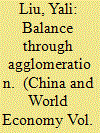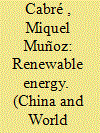| Srl | Item |
| 1 |
ID:
162632


|
|
|
|
|
| Summary/Abstract |
Changes in regional income gaps in China reflect the role of both the market and the government in the Chinese economy. Since 2003, government policies have aimed to distribute more resources to less developed areas. Although this process is accompanied by a narrowing interregional income gap, it does not represent real “convergence” between regions. From the perspective of spatial–political economics, the free movement of people is helpful to realize regional economic balance through agglomeration, while investment policies that deviate from the comparative advantage of less developed regions may lead to spatial misallocation of resources and unsustainable economic growth. In order to achieve further integration and development in the Chinese economy in the future, restrictions to the flow of production factors must be alleviated so that the market can truly become a decisive force for the allocation of resources.
|
|
|
|
|
|
|
|
|
|
|
|
|
|
|
|
| 2 |
ID:
162634


|
|
|
|
|
| Summary/Abstract |
The role of development finance institutions in low‐income and emerging countries is fundamental to provide long‐term capital for investments in climate mitigation and adaptation. Nevertheless, development finance institutions still lack sound and transparent metrics to assess their projects' exposure to climate risks and their impact on global climate action. To attempt to fill this gap, we develop a novel climate stress‐test methodology for portfolios of loans to energy infrastructure projects. We apply the methodology to the portfolios of overseas energy projects of two main Chinese policy banks. We estimate their exposure to economic and financial shocks that would result in government inability to introduce timely 2°C‐aligned climate policies and from investors' inability to adapt their business to the changing climate and policy environment. We find that the negative shocks are mostly concentrated on coal and oil projects and vary across regions from 4.2 to 22 percent of the total loan value. Given the current leverage of Chinese policy banks, these losses could induce severe financial distress, with implications on macroeconomic and financial stability.
|
|
|
|
|
|
|
|
|
|
|
|
|
|
|
|
| 3 |
ID:
162629


|
|
|
|
|
| Summary/Abstract |
Using data from the 2012 China Enterprise Survey conducted by the World Bank, this study examines the determinants of intangible investment by private manufacturing firms and its impacts on firms' productivity in China, thus shedding light on the recent development of intangibles in one of the largest emerging economies in the world. Higher human capital, larger firm size and better institutional quality are found to increase the propensity and the amount of intangible investment, yet fiercer market competition generally decreases both the propensity and the amount invested in intangibles. We provide evidence that the disaggregated components of intangibles are positively correlated with firm productivity and there is complementarity between software and organization investment. Implications for policies to enhance investment in intangibles are identified from the empirical results.
|
|
|
|
|
|
|
|
|
|
|
|
|
|
|
|
| 4 |
ID:
162631


|
|
|
|
|
| Summary/Abstract |
Based on data from the Chinese Industrial Enterprises Database, this paper investigates the effect of “Internet Plus” on the trade destination mix at the enterprise level. The analysis extends the classic dual margins to three dimensions: destination extensive, destination intensive and destination structural margins. The paper suggests that connecting to the internet not only raises Chinese firms' propensity to export, but also extends the destination extensive margin. In addition, Internet Plus could create a synergistic effect for internet‐enabled enterprises, that is, the development of the destination country's internet access benefits domestic firms' export participation. Finally, the paper finds that Internet Plus, rather than increasing the intensive or structural margins, leads to the transfer of exports to lower‐middle‐income countries and helps firms achieve competitiveness and thus increases their profit. The paper provides an explanatory mechanism and empirical evidence for firms' use of the internet to optimize export space.
|
|
|
|
|
|
|
|
|
|
|
|
|
|
|
|
| 5 |
ID:
162633


|
|
|
|
|
| Summary/Abstract |
In light of recent tax cuts by the US, should China reintroduce a preferential tax policy to attract foreign direct investment? This paper investigates whether China's 2008 tax policy change affected inward foreign direct investment. In contrast to previous studies, we break foreign investment down into suspect and real foreign investment using firm‐level data from 1998 to 2008 and conduct a difference‐in‐difference estimation to determine the effect of the tax policy change on both types of foreign investment and compare these to the effect on domestic investment. The results show that the 2008 tax policy change reduced the amount of suspect foreign investment and its effect on real foreign investment was insignificant, indicating that foreign firms in China are more concerned with the investment environment and economic stability than taxes. Therefore, China should create a regulated business environment instead of readopting supernational treatment for foreign enterprises.
|
|
|
|
|
|
|
|
|
|
|
|
|
|
|
|
| 6 |
ID:
162630


|
|
|
|
|
| Summary/Abstract |
This paper compares the global flows of Chinese overseas investment in power plants with renewable energy investment potential embodied in “Nationally Determined Contributions.” With over US$1tn (671 GW) in Nationally Determined Contributions renewable energy investment potential in developing countries, we estimate the total level of power plant investments from China's policy banks and commercial entities since the early 2000s at US$216bn (158 GW). Although past investment has mainly been directed at fossil fuels and hydroelectric power, we argue that China is uniquely poised to lead renewable energy global investments for three reasons: (i) China's solar and wind industries are globally competitive; (ii) Chinese policy banks can give domestic firms advantages in financing global expansion; and (iii) renewable energy investment opportunities still exist in developing countries with less sovereign risk than for traditional energy investments. The Chinese government should provide special incentives for the policy banks to capitalize on these investment opportunities by deploying Chinese solar and wind technologies to Belt and Road countries and beyond.
|
|
|
|
|
|
|
|
|
|
|
|
|
|
|
|